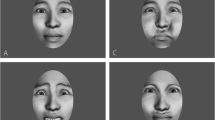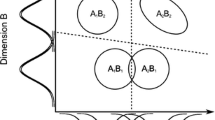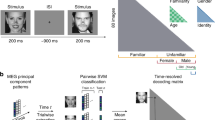Abstract
A recent model of face processing proposes that face shape and motion are processed in parallel brain pathways. Although tested in neuroimaging, the assumptions of this theory remain relatively untested through controlled psychophysical studies until now. Recruiting undergraduate students over the age of 18, we test this hypothesis using a tight control of stimulus factors, through computerized three-dimensional face models and calibration of dimensional discriminability, and of decisional factors, through a model-based analysis using general recognition theory (GRT). Theoretical links between neural and perceptual forms of independence within GRT allowed us to derive the a priori hypotheses that perceptual separability of shape and motion should hold, while other forms of independence defined within GRT might fail. We found evidence to support both of those predictions.




Similar content being viewed by others
Notes
We thank Dr. Lorraine Bahrick for suggesting the addition of this group.
References
Ashby, F. G., & Townsend, J. T. (1986). Varieties of perceptual independence. Psychological Review, 93(2), 154–179.
Bernstein, M., & Yovel, G. (2015). Two neural pathways of face processing: A critical evaluation of current models. Neuroscience & Biobehavioral Reviews, 55, 536–546.
Bruce, V., & Young, A. (1986). Understanding face recognition. British Journal of Psychology, 77, 305–327.
Burton, A. M., & Jenkins, R. (2011). Unfamiliar face perception. In The Oxford Handbook of Face Perception, 28, 287–306.
Duchaine, B., & Yovel, G. (2015). A revised neural framework for face processing. Annual Review of Vision Science, 1, 393–416.
Ekman, P., & Friesen, W.V. (1975). Unmasking the face: A guide to recognizing emotions from facial clues (Vol. 10). Ishk.
Green, D. M., & Swets, J. A. (1966). Signal detection theory and psychophysics (Vol. 1). New York: Wiley.
Haxby, J. V., Hoffman, E. A., & Gobbini, M. I. (2000). The distributed human neural system for face perception. Trends in Cognitive Science, 4(6), 223–232.
Hays, J., Wong, C., & Soto, F. A. (2020). FaReT: A free and open-source toolkit of three-dimensional models and software to study face perception. Behavior Research Methods, 52, 2604–2622.
Hosseini, S., & Soto, F. (2024). Multidimensional Signal Detection Modeling Reveals Gestalt-Like Perceptual Integration of Face Emotion and Identity Emotion. Manuscript accepted for publication in Emotion.
Krumhuber, E. G., Kappas, A., & Manstead, A. S. R. (2013). Effects of dynamic aspects of facial expressions: A review. Emotion Review, 5(1), 41–46.
Lai, M., Oruç, I., & Barton, J. J. (2013). The role of skin texture and facial shape in representations of age and identity. Cortex, 49(1), 252–265.
Lander, K., & Butcher, N. (2015). Independence of face identity and expression processing: exploring the role of motion. Frontiers in Psychology, 6(255), 1–6.
Lesmes, L. A., Lu, Z. L., Baek, J., Tran, N., Dosher, B. A., & Albright, T. D. (2015). Developing Bayesian adaptive methods for estimating sensitivity thresholds (d’) in Yes-No and forced-choice tasks. Frontiers in Psychology, 6, 1070.
Linares, D., & Lopez-Moliner, J. (2016). quickpsy: An R package to fit psychometric functions for multiple groups. The R Journal, 8, 122–131.
Maddox, W. T., & Ashby, F. G. (1996). Perceptual separability, decisional separability, and the identification-speeded classification relationship. Journal of Experimental Psychology: Human Perception and Performance, 22(4), 795.
Megreya, A. M., & Burton, A. M. (2006). Unfamiliar faces are not faces: evidence from a matching task. Memory & Cognition, 34(4), 865–876.
Rust, N. C., & Stocker, A. A. (2010). Ambiguity and invariance: two fundamental challenges for visual processing. Current Opinion in Neurobiology, 20(3), 382–388.
Silbert, N. H., & Thomas, R. D. (2017). Identifiability and testability in GRT with individual differences. Journal of Mathematical Psychology, 77, 187–196.
Soto, F. A., Stewart, R. A., Hosseini, S., Hays, J., & Beevers, C. G. (2021). A computational account of the mechanisms underlying face perception biases in depression. Journal of Abnormal Psychology, 130(5), 443–454.
Soto, F. A., Vucovich, L. E., & Ashby, F. G. (2018). Linking signal detection theory and encoding models to reveal independent neural representations from neuroimaging data. PLoS Computational Biology, 14(10), e1006470.
Soto, F. A., Vucovich, L., Musgrave, R., & Ashby, F. G. (2015). General recognition theory with individual differences: A new method for examining perceptual and decisional interactions with an application to face perception. Psychonomic Bulletin & Review, 22, 88–111.
Soto, F. A., Zheng, E., Fonseca, J., & Ashby, F. G. (2017). Testing separability and independence of perceptual dimensions with general recognition theory: a tutorial and new R package (grtools). Frontiers in Psychology Perception Science, 8(696), 1–18.
Townsend, J., & Wenger, M. (2014). On the dynamic perceptual characteristics of gestalten: Theory-based methods. In J. Wagemans (Ed.) The Oxford Handbook of Perceptual Organization.
Townsend, J. T., Liu, Y., Zhang, R., & Wenger, M. J. (2020). Interactive parallel models: No Virginia, violation of miller’s race inequality does not imply coactivation and yes Virginia, context invariance is testable. The Quantitative Methods for Psychology, 16(2), 192–212.
Ungerleider, L. G., & Haxby, J. V. (1994). ‘What’ and ‘where’ in the human brain. Current Opinion in Neurobiology, 4, 157–165.
Wagenmakers, E., & Farrell, S. (2004). AIC model selection using Akaike weights. Psychonomic Bulletin & Review, 11(1), 192–196.
Wang, Y., Fu, X., Johnston, R. A., & Yan, Z. (2013). Discriminability effect on Garner interference: evidence from recognition of facial identity and expression. Frontiers in Psychology Emotion Science, 4(943), 1–11.
Author information
Authors and Affiliations
Corresponding author
Additional information
Publisher's Note
Springer Nature remains neutral with regard to jurisdictional claims in published maps and institutional affiliations.
Supplementary Information
Below is the link to the electronic supplementary material.
Rights and permissions
Springer Nature or its licensor (e.g. a society or other partner) holds exclusive rights to this article under a publishing agreement with the author(s) or other rightsholder(s); author self-archiving of the accepted manuscript version of this article is solely governed by the terms of such publishing agreement and applicable law.
About this article
Cite this article
Martin, E.R., Hays, J.S. & Soto, F.A. Face shape and motion are perceptually separable: Support for a revised model of face processing. Psychon Bull Rev (2024). https://doi.org/10.3758/s13423-024-02470-y
Accepted:
Published:
DOI: https://doi.org/10.3758/s13423-024-02470-y




